There are 16 Flags for French-Heritage People in North America: Which One Represents You?
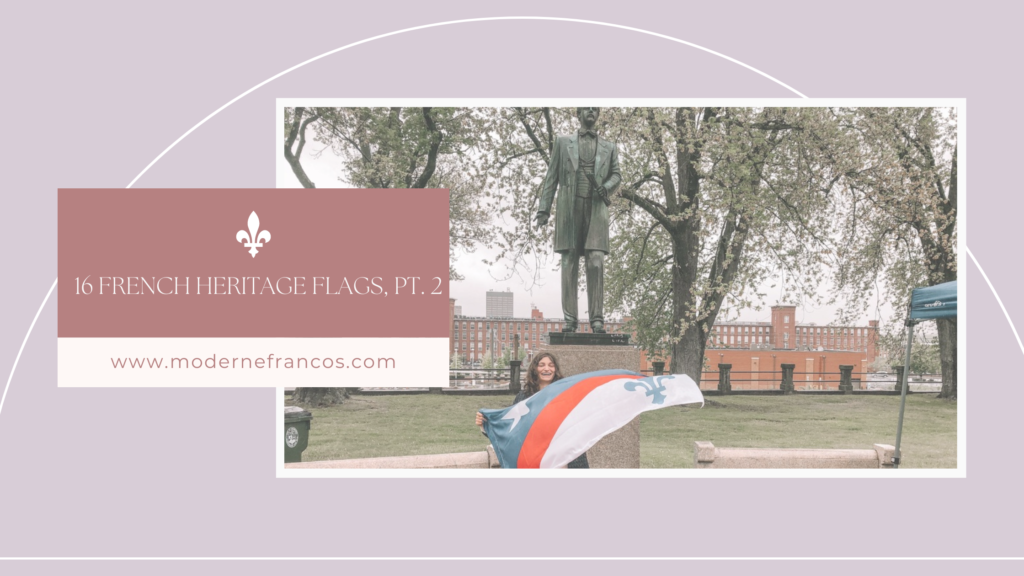
Wrapping up the French-Canadian flags from Part 1, this flag series continues with the last two of the flags of French-Canada. So, let’s cover these two flags and move on to the flags of Franco-America and Acadie!
Disclosure: Some of the links below are affiliate links. This means that, at zero cost to you, I will earn an affiliate commission if you click through the link and finalize a purchase.
The Franco-Ontarian Flag
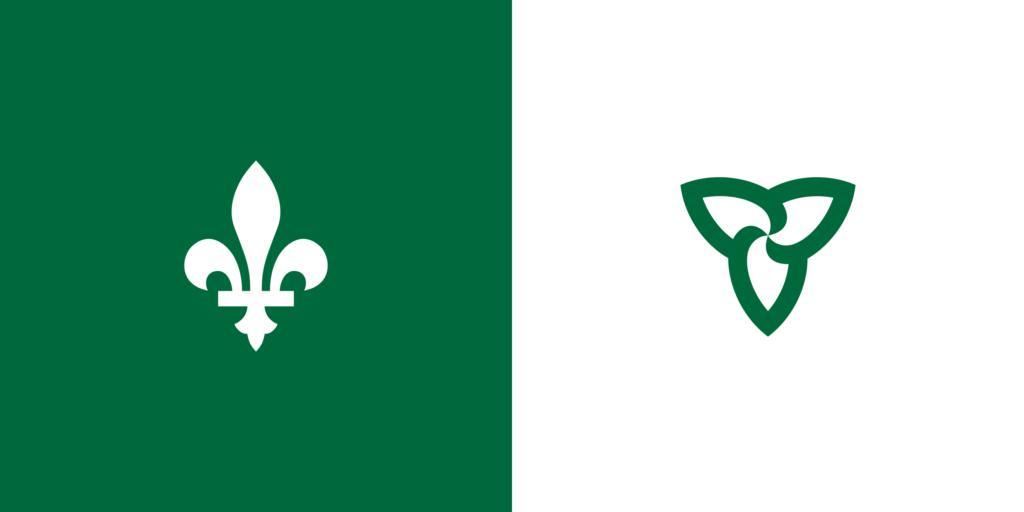
This flag represents the Franco-Ontarians in Ontario, Canada. Created as a collaboration between Laurentian University professor Gaétan Gervais and three of his students, Michel Dupuis, Donald Obonsawin and Yves Tassé, the Franco-Ontarian flag flew for the first time on September 25, 1975, at the University of Sudbury.
The Franco-Ontarian flag was officially adopted by the Franco-Ontarian community through the Association Canadienne-Française de l’Ontario in 1977.
This flag’s design features:
- A green and white background.
- A white fleur-de-lis over the green section on the left side.
- A stylized green trillium over the white section on the right side.
- The green represents summertime and the white represents wintertime.
- The White Trillium is Ontario’s official flower, commonly found in its woodlands.
- The fleur-de-lis symbolizes the French-Canadian heritage of the Franco-Ontarians.
The flag was legally recognized as the official flag of the Franco-Ontarians with the passage of the Franco-Ontarian Emblem Act of 2001. Through this act, the Ontario French-speaking community reserved the right to have their children receive primary and secondary school instruction in the French language in Ontario.
It also recognized the Franco-Ontarian flag as the emblem of the Ontario French-speaking community and the emblem of Ontario. In 2003, the flag was available as a graphic on license plates in Ontario!
The Fransaskois (Franco-Saskatchewanais) Flag
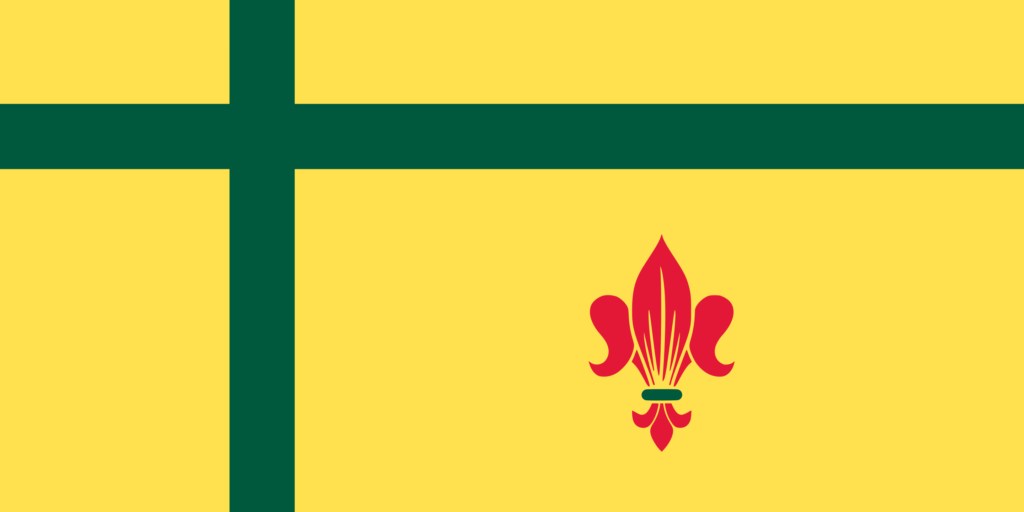
This flag represents Fransaskois, also known as Franco-Saskatchewanais or Franco-Saskatchewanians. This cultural group are French-Canadians or Francophones residing in the province of Saskatchewan, where approximately 17,735 residents stated that French was their first language, according to the 2016 Canadian Census.
Also in the Census, about 125,810 residents claimed full or partial French ancestry. The majority of Franco-Saskatchewanians live in the province’s three most populated cities of Saskatoon, Regina, and Prince Albert.
In 1974, the Conseil culturel fransaskois was established as an organization to help Francophone cultural centers in Saskatchewanian. Franco-Saskatchewanians regularly celebrate their culture with the folk arts, visual arts, fine arts, and performance arts in festivals like the annual Fête fransaskoise festival held in June since 1980.
The Fransaskois flag was created in 1979 to represent the Franco-Saskatchewanian community. This flag features:
- A green cross on a yellow background.
- A red fleur-de-lis in the bottom right corner, which represents historical figure Louis Riel and the struggle for the rights of Francophones and the Métis.
- The color green symbolizes the boreal forest of pine trees, spruces, and larches, as well as the historic role of the Roman Catholic Church in the community.
- The color yellow symbolizes the Canadian Prairies of Western Canada and includes a section of the Great Plains.
The first Francophones in the region were French-Canadian coureurs des bois, the runner of the woods or fur traders during the 18th century. Francophone settlements entered the region with fur traders, Roman Catholic missionaries, and the Métis in the 19th century.
In 1885, Louis Riel led the North-West Rebellion of Francophone Métis in the region. By the early 20th century, the provincial government attempted Anglophone assimilation of the Francophone minority by cutting French language education.
In 1982, the enactment of the Canadian Charter of Rights and Freedoms resulted in several decisions from the Supreme Court of Canada that reaffirmed the educational and judicial rights of Francophones in Saskatchewan.
Flags of Acadie
Now we’re moving on to the flags of Acadie! The region of Acadie is located in eastern Canada, encompassing parts of what is now known as New Brunswick, Nova Scotia, and Prince Edward Island.
The Acadians were the early French settlers of this region, and their descendants today are known as the Acadians. They have a rich cultural heritage steeped in history and language, with their own unique dialect of French and traditions of art, music, and storytelling.
However, the Acadians also faced a history of political and social struggle, including the forced Expulsion, or Le Grand Derangement, by the British in the mid-18th century. Despite this, the Acadian people have preserved their culture and traditions, creating a dynamic and vibrant community that extends far beyond the borders of Acadie.
Flag of Acadia
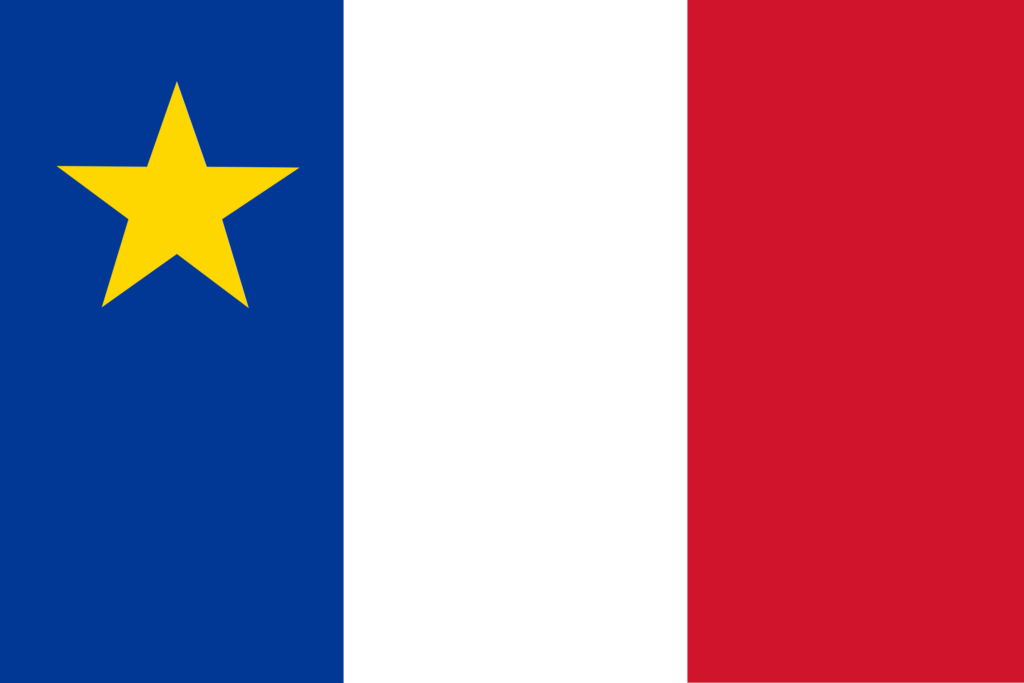
This flag represents the Acadians, a French-heritage cultural community of Canada. On August 15, 1884, the Acadian flag was adopted at the Second Acadian National Convention in Miscouche, Prince Edward Island. The convention was attended by nearly 5,000 Acadian delegates from across the Maritimes.
The Acadian flag was designed by Father Marcel-Francois Richard, a priest from Saint-Louis-de-Kent, New Brunswick. This flag features:
- The blue, white, and red tricolor as seen on the flag of France.
- A gold star inspired by the papal colors of the Pope, Catholic Church, and Vatican City.
- For the Acadian flag, the star represents devotion to the Virgin Mary.
- The French tricolor was chosen to represent the French roots of the Acadians.
- The color blue symbolizes the distinct Acadian nationality and the star of the Blessed Virgin of the Assumption, the patron saint of the Acadians.
- The gold star also symbolizes a starfish guiding sailors “through storms and reefs.”
Father Richard was quoted stating, “I wish that Acadia had a flag reminding not only that its children are French, but also that they are Acadians.”
The Acadian flag’s creation was a vital part of the Acadian Renaissance, a time of higher cultural activity among Acadians to redefine the nature of the Acadian community. It was also an opportunity to recover from the trauma of Le Grand Derangement also known as the Great Deportation, the Great Upheaval, the Expulsion of the Acadians, or the Deportation of the Acadians.
This growing interest in the history of Acadia sparked the Acadian Renaissance, the beginnings marked by the founding of the first Acadian newspaper, Le Moniteur Acadien in 1867.
Acadian culture is rich with traditions such as Tintamarre in celebration of National Acadian Day. In this tradition, Acadian communities use noisemakers and instruments to make noise throughout the streets to represent their presence or to remind others of the Acadian presence.
Flag of Acadiana / Cajun Flag
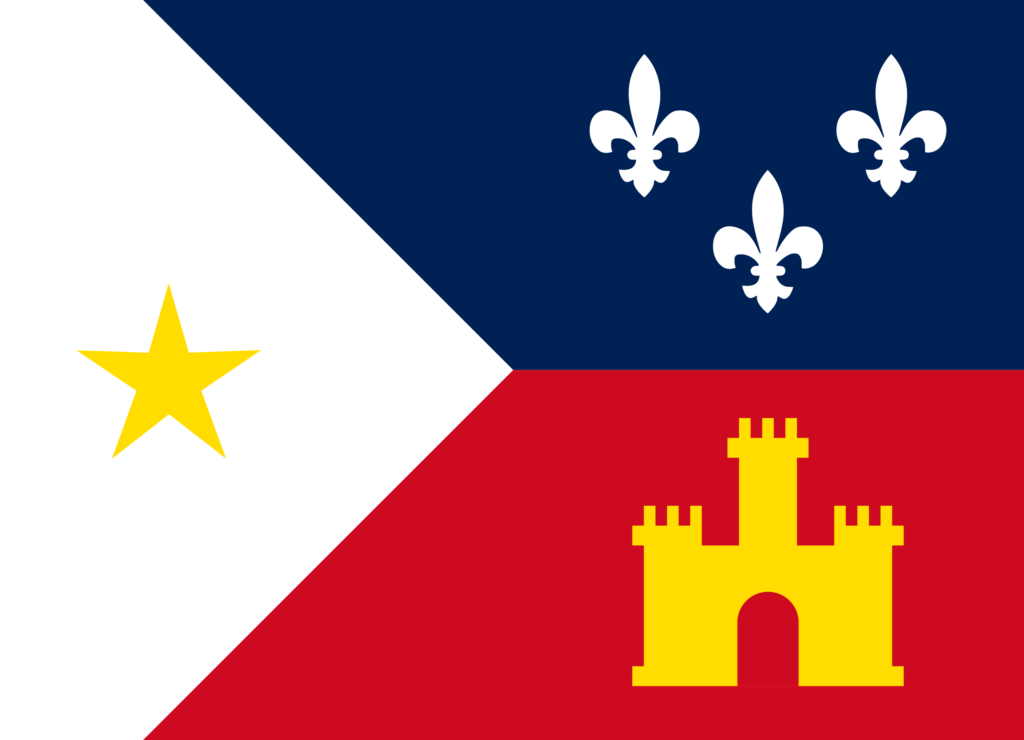
This flag represents Louisiana Acadians, also known as Cajuns. It was designed in 1965 by Dr. Thomas J. Arceneaux of the University of Southwestern Louisiana, known today as the University of Louisiana Lafayette.
Arceneaux derived the flag’s design from the university institute seal, which features similar symbols to the flag. He was an early proponent of the Louisiana French Renaissance Movement, which encouraged renewed interest in the French-Acadian heritage, language, and culture of Louisiana.
This flag’s design features:
- Two equal horizontal sections of blue and red.
- Three white fleur-de-lis in the blue section, which represents the French ancestry of the Cajuns.
- The gold castle in the red section represents the Spanish colonial rule when the Acadian exiles found themselves in Louisiana.
- A white triangle section to the left of the blue and red.
- A five-pointed gold star in the white section symbolizes the Acadian exiles of Le Grand Derangement.
- The white section symbolizes the Roman Catholic faith of those Acadians in the region.
Dr. Arceneaux’s design was officially adopted as the official flag of Acadiana on July 5, 1974, by the State Legislature.
Flag of New England Acadians
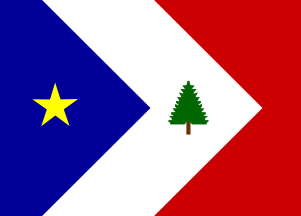
Another tricolor flag featuring the green pine tree is the flag of the New England Acadians. We know that the yellow star on this flag and The Valley flag above comes from the Acadian flag. We also know that the fleur-de-lys on The Valley flag represents the French heritage of the region. But what does the pine tree on The Valley flag and this flag for New England Acadians represent?
This flag features:
- A pine tree symbolizing the New England region of the United States.
- A blue, white, and red triangle in the tricolor of the Acadian flag.
- The yellow Acadian star in the blue section on the far left.
The creator of the New England Acadian flag, William J. Cork, explained in a blog post that he was inspired to create this flag to give representation to Acadians in New England.
He got the idea to use a pine tree in the design from the Flag of New England adopted in the 17th century. This flag is mostly red with a small white square in the upper left-hand corner with the green pine tree. Specifically, the Eastern white pine which is the most prominent tree found throughout New England.
More insight about the New England Acadian flag from the blogger:
“My design for a New England Acadian flag combines the Acadian flag with the 17th/18th-century flag of New England…The New England Acadians who saw me wearing it at Grand-Pré on August 13 [2004] were quite enthusiastic. Before a talk by Lucie LeBlanc Consentino on our New England Acadian Heritage we convened an impromptu Society of New England Acadians and officially adopted it.”
Flags of Franco-America
Franco-America refers to the population of people in the United States who are of French heritage. In many Franco-American circles, the term can extend to those who are of French-Canadian, Acadian, or Cajun descent.
Franco-Americans have a rich cultural heritage distinctly shaped by the blending of French-Canadian and American cultures.
Flag of United Franco-Americans
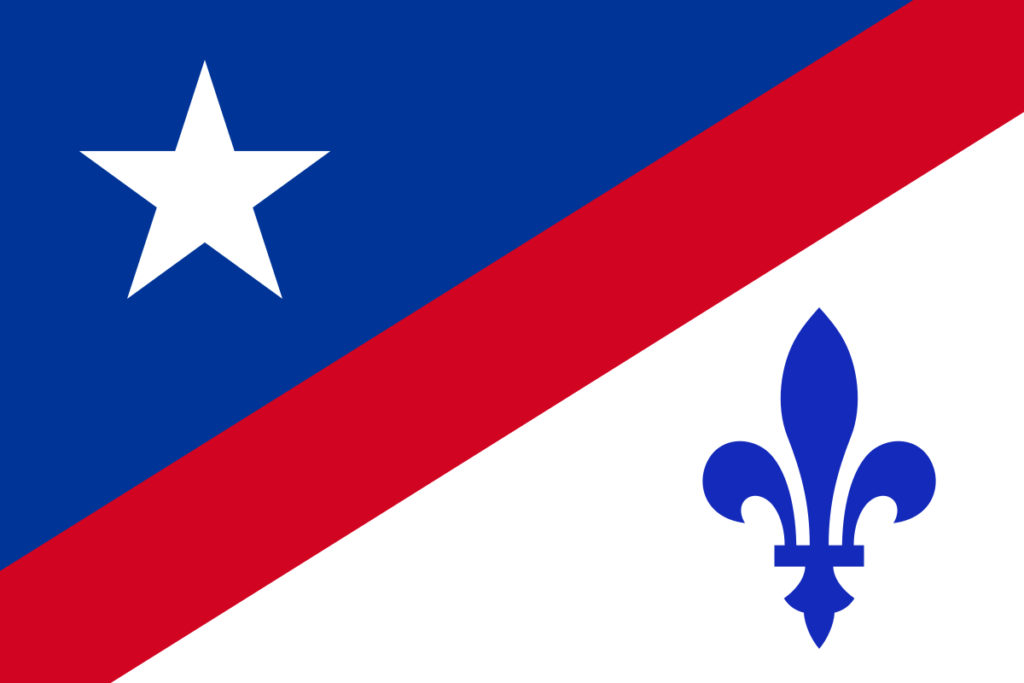
This flag represents all Franco-Americans in the United States, but its origins aren’t as clear as the other flags in this lineup. Luckily, we can work off of context clues and some online digging to find some answers.
This flag’s design features:
- The red, white, and blue tricolor of the American flag and the flag of France.
- A white star on the top left symbolizing the unity of Franco-Americans and solidarity with the U.S.
- A blue fleur-de-lis in the same style as found on the flag of Québec, symbolizing a connection to La Belle Province.
As stated in one of my older posts about the Franco-American flag, it is claimed that this Franco-American flag was given to Édith Butler, a Canadian singer-songwriter of Acadian heritage.
While performing for her concert tour on June 24, 1992, in Manchester, New Hampshire, she displayed the flag given to her by the Franco-American community of New Hampshire, Vermont, Massachusetts, and Upstate New York.
Although some details about this flag remain shrouded in mystery, it’s clear that this was a collaboration project between interested parties to recreate the flag and document the history and culture of Franco-Americans. And for that, Franco-Americans thank you all for this beautiful flag!
Flag of Midwest Franco-Americans
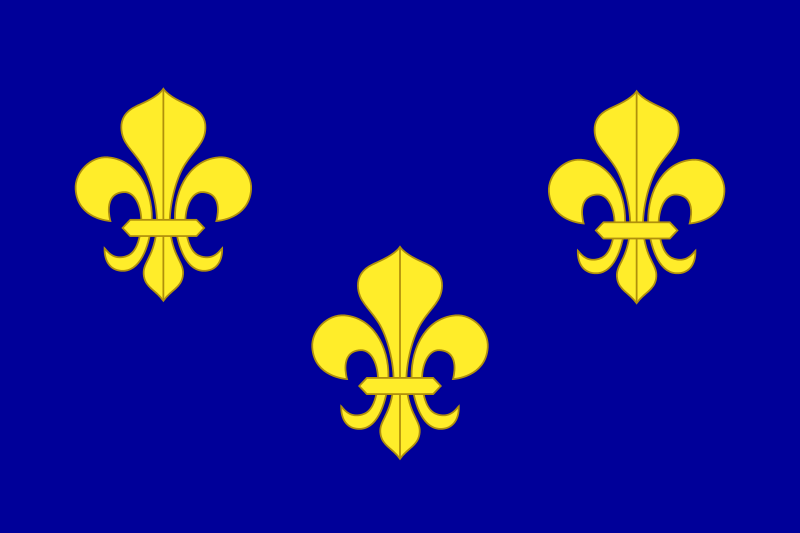
This flag represents Franco-Americans in the Midwest of the United States. However, my research about this flag came up short and it appears not much is known about it online. So, if you’re a Midwest Franco-American who knows more about this flag, please reach out so I can properly give this flag its dues.
This flag’s design features:
- A blue background, perhaps representing the blue found on the American flag, the flag of Québec, and the flag of France.
- Three yellow fleur-de-lis, symbolizing the French heritage of Franco-Americans.
What I did find about this flag was that it appears to be the same flag design as the pre-1790 French Flag. As seen here and here, the same flag is used to represent Midwestern Franco-Americans. It’s listed as such here, but with no more detail than the name of the region it represents.
Luckily, this flag is available for purchase online. Until I find out more about its origins and usage as a Franco-American flag, this section will remain as is. So, again, please reach out in the comment section or contact me via email or social media if you know more about this flag!
Flag of New England Franco-Americans

This flag represents Franco-Americans in New England and/or the United States. It’s been on the scene for a number of years, but it’s mostly referred to online as the “Franco-American Flag of New England.”
Designed by Robert L. Couturier, an attorney and one-time mayor of Lewiston, Maine, the flag was adopted in May 1983 at a Franco-American conference at Saint Anselm College in Manchester, New Hampshire.
This flag’s design features:
- A blue background represents the blue found on the American flag, Québec flag, and flag of France.
- A white fleur-de-lis symbolizes French heritage, including French-Canadian and Franco-American heritage.
- A white five-pointed star represents the United States, inspired by the stars on the American flag.
The flag was officially adopted by other Franco-American organizations in the rest of the Northeast U.S., parts of the Midwest, and eventually approved to be the national Franco-American flag.
Did I miss any other French-heritage flags of North America? Let me know if there are more flags below!
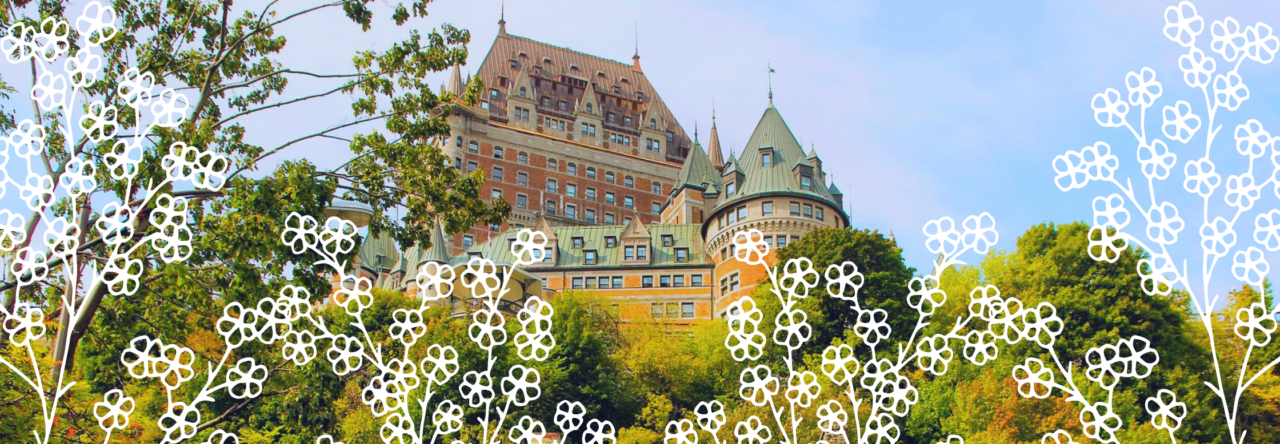
Thomas Meyer
The French in Southeast Michigan are the Muskrat French. The language was French but was it`s own dialect. There is an article online about the Muskrat French. Around Monroe Michigan ( Frenchtown) was all French speaking at one time. My mothers generation was the last to speak French.
Melody Desjardins
Hi Thomas! That’s interesting: I’ve never heard of the “Muskrat French” before. I’ll look it up! Merci for your comment.
MARIO PERIARD
You said the generation of your mother is the last to speak french. Is your mother still alive? Are there other french speakers still alive?